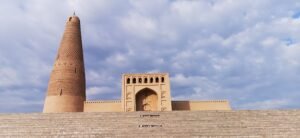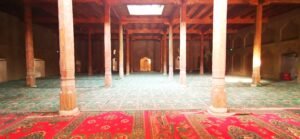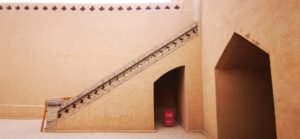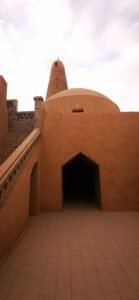The Xinjiang autonomy region has been mysterious not only to aliens but also to many Chinese like me. It had been the west gate of China for thousands of years, nurturing the Uygur people and being a significant node in the ancient Silk Road. Benefiting from the prosperous international trade, Islamic culture developed well here, and some excellent Islamic architectures were boosted.
My travel along the ancient Silkroad in southern Xinjiang
I have been to Urumqi, the capital of the Xinjiang autonomy region at 5 years old, thus for a long time I treated myself as a Xinjiang visitor, till I recognized how vast this region was in a map of Chinese territory. I decided to drive across southern Xinjiang, the south part divided by the Tianshan Mountain, circling the Taklimakan desert in October 2023, to become a part-Xinjiang visitor.
Before my journey, I spent much time searching for information about the charming culture other than the Han region and found my planned route overlying the ancient Silk Road exactly. There must be various interesting things about multi-cultural exchanges in this pathway.
I launched my journey from Chongqing City, southwest China, after 3 days of driving, I got to Hami, the east Xinjiang city, this was the point where I started my circle around the Taklimakan desert.
An Islamic architecture lost in Turfan
Turfan was the second city I visited, where was still half-developed modern urbanization stopped unexpectedly on the boundary of the ancient town. You can access both advantageous urban facilities and Uygur traditions simultaneously, which would be an amazing experience.
Among numerous old residences, I noticed an Islamic mosque in the ancient part of this city. The locals told me it was established in the Qianlong period, Qing dynasty, which means this antique architecture had stood for more than 230 years. I am delighted to hear that and this building would be my first impressive architectural view in Xinjiang.

The mosque named Emin Minaret was built by a local lord, Emin Khjor, who was the ruler of Turfan under the govern of emperor Qianlong of the Qing dynasty. He demonstrated loyalty to the central government by defeating the rebellions twice, for prize, Qianlong awarded him a duke title. His son built this architecture to commemorate his achievements after his death.
The layout of the mosque
Frankly, I didn’t realize it was a mosque at first glance. It was so different from what I saw in other Muslim regions. No spectacular dome was set in the center of the layout, and neither were minarets at the four corners of the complex. I preferred to classify it as a modern architecture for its irregular arrangement of each volume.

From the perspective of the front yard, the monument comprised two parts, a minaret, and a cubic pavilion. They were both settled in the right places outlining a dramatic skyline, vertical and horizontal, curved and linear. It was sited on a brick terrace as most Chinese palaces did, to emphasize its prominent role in this yard.

The cubic pavilion was a chapel. Like most chapels in other mosques, it was a rectangular hall full of pillars, a beam of lights cast into the room through the louver shining a Muslim priest. Around the main room were configured niches, unfortunately, most of which were forbidden to visit.

There were a few tiny yards in the cubic mosque for ventilation and lighting reasons, I guess. But another function of it may be the transitional place to the top of the wall since I found stairs connecting there.
Features of Islamic architecture
Islamic architecture holds various identical features distinguishing it from others. When concerning the construction aspect, the large dome may be the most explicit component like what you can find in the Istanbul Santa Maria Cathedral. Unfortunately, I just found a small one beside the tiny courtyard.

The minaret was built in another way rather than that of the common mosque, which looked like a pillar. The Emin Minaret was filled with bricks, however, there appeared several brick textures along the elevation of the body, and it looked very detailed. When viewed from a distance, the tower seemed wrapped with a local carpet.

Islamic arch was the most applied feature in this mosque, but like the former two features, it was also adjusted by some Xinjiang traditions. The arch in the chapel was triangular, rather than the pointed arch found applied on the front façade.
Staring at the gate, I considered its style may be influenced by the ancient architecture of Mesopotamia, for the volume was an emphasized cube much taller than the surrounding walls, with an amplified Islamic arch settled in the center of the façade controlling the whole layout. It’s looking seemed like the gate of Ur cities.
The Emin Minaret excited me at the very beginning of the Xinjiang journey. The multi-cultured architecture indicated a diversity of interesting relics or heritages in the deeper Taklimakan desert along the ancient Silk Road. I could not wait to explore ahead.


